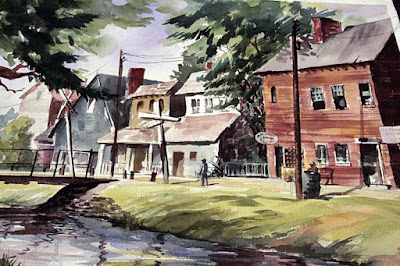10/19 - The House on Turk Street
Answer any of the following questions about Hammett's "The House on Turk Street:"
- Hammett uses many descriptions of physical appearances, as well as descriptions of voices throughout "The House on Turk Street." What is the purpose and effect of these descriptions? Provide examples in your answer.
- What did you notice about Hammett’s depiction of the women in this story? What kinds of stereotypes does he use?
- Is the style of this short any different from previous short stories we’ve read for class? If so, what are some defining characteristics of the “detective style?” Give some examples.



By Sarah Kurzweil
ResponderExcluirHammett uses descriptions of physical appearances and voices to show that people are not always what they appear to be on the surface. This is most evident in the case of Mr. and Mrs. Quarre. When the narrator first meets them, he describes them as an “affectionate old couple” (4). Mrs. Quarre is a “little fragile woman” and Mr. Quarre is “old too, and stout, with a thin white beard that fell upon a white vest that was as stiffly starched as the woman’s apron” (4). From these descriptions, and through their friendly conversation with the narrator about their neighbors, Mr. and Mrs. Quarre seem to be calm, old people, incapable of causing any harm. It quickly becomes clear, however, that they are not innocent. When Tai instructs Mr. Quarre to watch the narrator, “From somewhere among his whiskers, his coat, and his stiff white vest, the old man brought out a big black revolver, which he handled with no signs of unfamiliarity” (6). His “stiff white vest,” once a sign of his age and innocence, becomes a tool used to conceal both his weapon and his true, malicious identity (6). At the end of the story, Mr. and Mrs. Quarre come back to the house because they suspect that Tai is not planning on giving them their money. When they return, the narrator says that he “found little of the friendly fragile one who had poured tea and chatted about the neighbors” (22). Instead, he now sees “a witch of the blackest, most malignant sort” and a “thin body fairly quivered with hate” (22). In his descriptions of the physical appearances of Mr. and Mrs. Quarre, Hammett makes it clear that they are not innocent like the narrator once perceived them to be. In turn, Hammett shows how the true power of a criminal and a detective is found in his ability to use his personality to trick his opponents.
There are two female characters in this story, Mrs. Quarre and Elvira. To me, both characters express or demonstrate stereotypes, yet they do so in ways to their advantage and therefore actually transcend them.
ResponderExcluirFor example, when the narrator first encounters Mrs. Quarre, she depicts herself as acting out of “an old woman’s timidity,” (3) a stereotype of women seen as “fragile” or “cautious.” We initially then see Mrs. Quarre as this innocent, harmless woman until, well, she’s not. We realize that this entire time, she’s been acting so innocently in order to waste time and distract the narrator until the other three arrive. In this way, Mrs. Quarre uses stereotypes of women and turns them around to her advantage, thereby demonstrating her personal strength and brilliance and transcending the stereotype.
And then for Elvira, her ability to use the stereotypes to her advantage was even more extensive, at least because the story gave more detail to her actions. The narrator himself even describes her to be “as beautiful as the devil, and twice as dangerous” (10). To me, this line sums up her character. She’s beautiful, but she’s no prey to the stereotypes that might come with that. She even takes it further in being “twice as dangerous” in that she turns the stereotypes of a woman who’s beautiful, such as a helpless “damsel in distress,” and uses them to her advantage. She’s so good at this that narrator explains at the end that none of the young guys she tricked ever told the police anything about her or her criminal plans and that “some of them had gone to great trouble to keep her out of it” (25).
If we were not to necessarily focus on perhaps the morality or the “what” of both characters’ specific actions in how they transcended stereotypes and used them to their advantage but focus more on the very fact that they did, I think that they can be seen as truly strong characters.
Mike Neary
Hammett’s use of color in his descriptions of Hook, Elvira, and Tai stuck out to me. As the house, the main setting of the story, is lit by “the glow that filtered through the glass from the street lights” (17), it’s interesting how Hammett assigns one of the traffic colors to each criminal as a symbol of their role in the group.
ResponderExcluirElvira is described as the “Red-haired she-devil”, with “flame-colored hair. Smoke-gray eyes that were set too far apart for trust-worthiness - though not for beauty” (10). The collocations “flame-colored” and “smoke-gray” evoke the imagery of fire, symbolizing her destructive and dangerous nature beneath of her beauty. With the idea that “the eyes are the windows to the soul” in mind, the imagery of hers as smoky suggests that she has hidden intentions and as the detective says, should not be trusted. So as in traffic lights, her redness sends the message that one should stop before getting close to and trusting her.
On the other hand, Hammett illustrates Tai, due to him being Chinese, as yellow: “His face was a round yellow mask” (12). In the context of the traffic lights, yellow is clearly a symbol of caution, and therefore encapsulates Tai’s more careful and calculative attitude in the crime (e.g. he stops Hook from being reckless and killing the detective in order to avoid more deaths, he attempts to civilly make a deal with the detective after weighing each of their potential gains and losses, etc.). However, the idea of his face being a “mask” also hints at hidden intentions underneath his appearance of reason -therefore, the traffic light analogy also works here as the yellow sends the message to the detective that he should still be cautious and slow down when approaching Tai.
Less obviously, Hammett assigns Hook the color green. The detective observes “a scowling Hook whose freckles had a greenish tinge against the sallowness of his face” (9). The noun “sallowness” gives him the sense of being sickly and weak, which extends to his mental state as well as he’s described as having “the instincts and intellect of a troglodyte” (9). In the context of traffic lights, green means go, which Hook literally does due to his weak and reckless character -e.g. he punches Tai and wants to kill the detective without thinking about the consequences.
As compared to the other short stories we have read in this class, Dashiell Hammett’s “The House in Turk Street” is typical of the detective genre for its continually rising action and extensive use of dialogue for plot exposition. Although the story begins with the mystery of the man detective “Mr. Tracy” is in search of, nothing prepares the reader for the series of fast paced series of events and plot twists that take place. The only story that compares to “The House in Turk Street” in terms of action is Donald Barthelme’s “The School”, when a school is plagued increasingly absurd deaths. A key difference between these two stories however, is the lack of a clear pattern established in “The House in Turk Street”. From the friendly Quarre couple to the British mastermind to the detective himself, no one is who he or she seems to be. The Quarres turn out to be cutthroat criminals, the British man is revealed to be of Chinese descent, and we learn that the detective is investigating an ordinary runaway instead of the Los Angeles Heist. This writing style forces the reader to become more engaged assume the role of the detective and continually question any and all facts presented throughout the story. Hammett also relies on dialogue more so than the other authors we have read to develop the story in order to create a fast-paced action thriller. Other authors such as Kate Chopin, Herman Melville, and Jack London only used dialogue when necessary, and instead focused more on symbolism and character development. Hammett, on the other hand, is able to tell the reader his main characters’ backstories and motivations with a few lines of dialogue. This technique forces the reader to quickly adjust and readjust to new plot developments, thereby creating a more exciting storyline.
ResponderExcluir-Shrenik